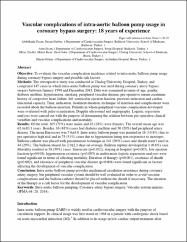| dc.description.abstract | Objective: To evaluate the vascular complication incidence related to intra-aortic balloon pump usage during coronary bypass surgery and possible risk factors. Methods: The retrospective study was conducted at Uludog University Hospital, Turkey, and comprised 147 cases in which intra-aortic balloon pump was used during coronary artery bypass surgery between January 1994 and December 2011. Data was examined in terms of age, gender, diabetes mellitus, hypertension, smoking, peripheral vascular disease, pre-operative serum creatinine, history of congestive heart failure, left ventricular ejection fraction, previous infarction and cardiac functional capacity. Time, indication, treatment duration, technique of insertion and complications were recorded about the balloon insertion. Patients in whom peripheral vascular complication developed were evaluated with pulse examination, Doppler ultrasound and angiography. Logistic regression analyses were carried out with the purpose of determining the relation between pre-operative clinical variables and vascular complications and mortality. Results: Of the total, 105 (71%) were males and 42 (28%) were females. The overall mean age was 62.4 +/- 10.1 years. Besides, 16(41%) cases had diabetes mellitus and 30(20%) had peripheral artery disease. The mean Euroscore was 7.6 +/- 4.8. Intra-aortic balloon pump was inserted in 16 (10.8%) due to pre-operative high risk and in 75 (51%) cases due to hypotension being non-responsive to inotropes. Balloon catheter was placed with percutaneous technique in 141 (96%) cases and sheath wasn't used in 44 (29%). The balloon stayed for 2.9 +/- 2.1 days on average. Balloon rupture developed in 1 (0.6%) case. Mortality resulted in 58 (39%) cases. Euroscore (p=0.012), staying in hospital (p=0.005), low ejection fraction (p=0.018), hypertension existence (p=0.003) in multivariate logistic regression analyses were found significant in terms of affecting mortality. Duration of therapy (p<0.001), existence of sheath (p=0.002), and existence of peripheral vascular disease (p<0.001) were found significant as factors affecting the development of vascular complication. Conclusion: Intra-aortic balloon pump provides mechanical circulation assistance during coronary artery surgery, but peripheral vascular system should be well evaluated in order to avoid vascular complications and the balloon catheter should be placed without the sheath if necessary. The duration of the therapy is a risk factor for the development of vascular complication. | en_US |


















